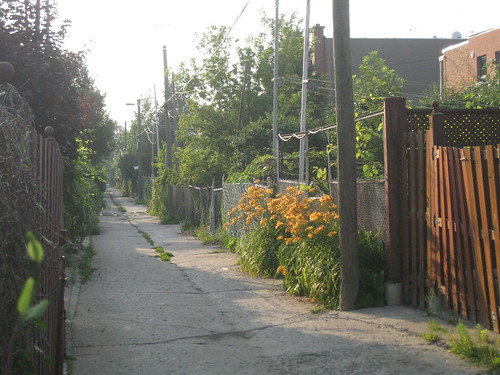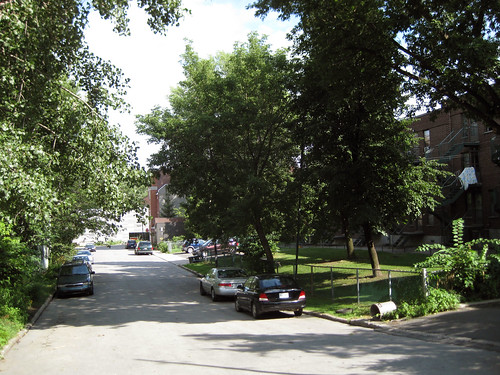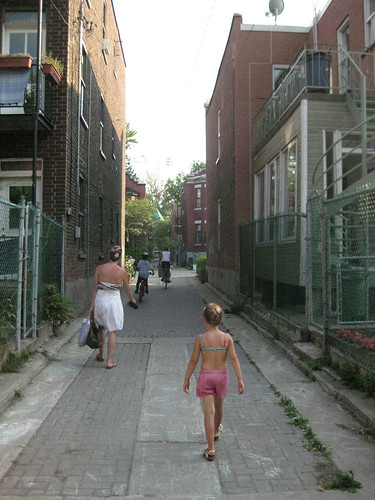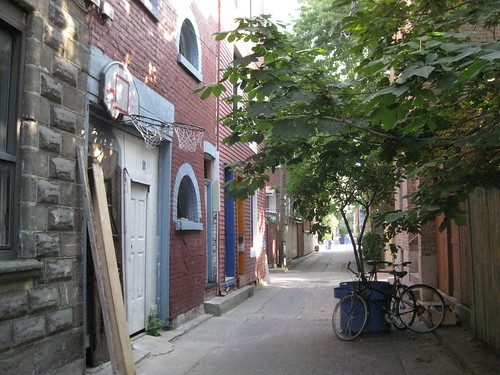When I asked readers to name their favourite alleyway in our survey, I didn’t expect to run up against this roadblock: what is an alleyway anyways?
The official definition is “a narrow street; especially a thoroughfare through the middle of a block giving access to the rear of lots or buildings.”
According to the Centre d’histoire de Montréal, alleyways as we know them first appeared in Montreal around 1845 when large farm-lots were being subdivided into smaller properties. Prior to this, inner courtyards were accessible through private carriage doors, but not from the street. The McTavish property was the first to be planned and subdivided with alleyways in the H-configuration that has since become common in Montreal’s neighbourhoods.
These days, some alleyways have names – some are even called avenues – and these ones generally got the most votes: Demers, Saint-Christophe, Chateaubriand, and Lartigue each got lots of mentions, perhaps simply because they were the easiest to identify. Although they fit the official definition (narrow street; and acess to some rear lots) these alleys a far cry from your typical Montreal ruelle: there are addresses on each of these streets, and some even have sidewalks or parking lanes.
Yet they seem to fall somewhere between rue and ruelle and the rules that quietly organise our urban form fall aside in these places. The streetfront oscillates wildly between front doors that open direclty onto the pavement and deep pockets of back yard. From a birds-eye-view these streets look like jack-o-lantern teeth. On the ground, front steps alternate with spiral fire escapes, picket fences, and backyard tomato gardens. Balconies overhang sidewalks, electrical wires, vines and clothes-lines all cross-cross overhead.

Rue Saint-Christophe (4 votes) is lined wiht just as many front doors as backyards.
Avenue Lartigue (4 votes), below Sherbrooke between de la Visitation and Panet, feels more like a regular street until it trails of into a dirt path and dead end.

Rue Demers (pictured between Hotel-de-Ville and De Bouillon) got 4 votes.

Avenue Chateaubriand picked up 2 votes (pictured below Mount Royal). This part of it fits the “narrow street” bill, but below Rachel some backyards face the laneway.
Groll (at least 4 votes) is not only car-free and cobble-stoned, but it has cross walks to create a continueous pedestrian passage across the Mile End.
Other alleys that got mentioned by name were Ruelle Nick Auf-der-Maur and Ruelle des Fortifications, which marks the boundary of the old walled city.
Nameless Alleys
Of course most of Montreal’s network of alleys have no name and this is where things get complicated: how does one cast a vote for something with no name? Some people carefully squared off their alley by naming the 4 surrounding streets, others simply tossed out one adjacent street, and still others described the atmosphere: “alleys of little Italy that smell of basil and where kids play hockey.”
But one trend that emerged was that people have a soft spot for those rare pedestrian-only alleyways that look and feel more like country lanes. All of these ones got mentioned more than once:

The alleyway near Gilford and Drolet, with its thick foliage and quaint lamp-post always makes me think of a passage to Narnia.

The alley east of Saint-Hubert, north of Viger.

I’ve written fondly about this alleyway between Melrose and Draper in NDG, but I swear I didn’t vote for it in the survey.
Alleys Everywhere
Almost all of the alleys that were highlighted by our readers were either streets-that-were-alley-like or alleys-that-were-path-like.
But exception stood out: the ruelle precisely between Fabre et de la Visitation and Marquette; St-Zotique et Bélanger (pictured at the top of this post and below), got a whole two votes, once in English and once in French. It isn’t a street, it isn’t a designated “ruelle verte” or a carefully maintained garden path, it’s just the space where people’s backyards spill out into the public sphere. It was also probably the most inhabited alley that I visited. Kids splashed in in-ground pools in their backyards and guitar chords floated in the heat, laundry flapped lazily, a woman crossed the lane to show off a garden-grown zucchini to her neighbour. The flowers were unruly and and ripe raspberries poked through fences.

Touring all these alleyways, I began to wonder why we don’t we fix them up as cycling paths, or pull up the concrete and plant community gardens (especially for those of us on the upper floors), or close them down for block parties?
Right now, most alleyways seem to be in limbo – they are a little bit intimate, a little unruly, and a little neglected. So perhaps the most inspiring answer to the “favourite alleyway” question where those who simply answered “my alleyway.”






14 comments
Wonderful article… someone should map out all the best examples and make a website.
…I’ve made a map of my favourite streets in the Plateau and the Village, including the ruelles vertes, here: http://maps.google.com/maps/ms?msa=0&msid=111874201147413300649.00044d0966e418fcd829b
It’s open to anyone so you can add yours to it, too :)
Tux, there IS an interactive online map of the Ruelles Vertes, at least in the Plateau and Ville-Marie Boroughs:
http://www.velo.qc.ca/eco_plateau/index.php?page=volets-ruelles-reseau
These are citizen-driven initiatives overseen by the eco-quartier. In NDG where I live, the eco-quartier has told me it’s hard to get a ruelle verte project going because a pretty big number of people on the block have to dedicate their time and energy to the project consistently (I was told it takes at least 6 people on the block).
Very cool article! I’m a fan of the one located east of Saint-Hubert, north of Viger.
Lovely – however these streets are never adjacent: Fabre et de la Visitation. This is just from memory, but as I recall rue de la Visitation ends at Sherbrooke at the north, while Fabre starts north of Parc Lafontaine. I think Fabre would be a few streets east of rue de la Visitation; two streets west of Papineau, which has the same name from north to south of island. As I recall, the street west of Fabre is Garnier; Marquette its eastern neighbour.
When I lived on the east side of Alma, between Dante and St-Zotique, there was no alley between our little Italian gardens and the ones facing on Henri-Julien; they were separated by walls or fences. Ours had a pergola, with a table underneath where my cat slept on hot days like today. It was a paradise for cats as it was hard for them to get out onto the street – though some of the younger, more agile and more desperate by wont of not being neutered managed to do so, by way of the roofs, and they had all the crops and flowers to explore. Before that, I lived on Casgrain just south of rue de Castelnau and École Ste-Cécile was on the other side of our pedestrianised ruelle.
I still live in the same general area as those places, though while the co-op apt I live in is great, our ruelle is much less interesting.
My one unrelated quibble is using Merriam-Webster as source of “the official definition”.
there are some great and not very well known alleys in Rosemont that are exquisite green oases unlike most in that borough which are full of garages and, thus, cars. my favourite: between Cartier and Chabot south of des Carrieres.
between Cartier and Chabot on the Plateau is pretty great too, between Masson and Laurier to be precise.
and the ruelle champêtre between Drolet and Henri-Julien between des Pins and Carré St-Louis has to be visited to see what can be done for $150k…
…the picture of Rue Demers isn’t showing its most impressive part just a block east, which is a rather exuberant display of flowers, and although I love it, I actually have objections to the fact that the sidewalks are so skinny as to make it less enjoyable to walk through — surely by design, but it feels unfriendly and as though you’re trespassing. And although I like that part of Avenue Lartigue, I actually prefer the section between de Maisonneuve and Logan — really quite amazingly cute.
I’m also surprised that Dalcourt didn’t get mentioned, although I guess it’s more a street. Plus it’s possible to walk along long stretch of bike paths / green spaces / occasional side street / alleyways from Place Saint-Henri all the way to oh, Guy or so, and although it’s not got much charm, it’s a great exercise in 70s urban planning.
I applaud this entry’s respectful use of street endonyms, but it is worth noting however that “Mount Royal” doesn’t exist anywhere.
Newmontréal,
http://maps.google.com/maps?f=q&source=s_q&hl=en&geocode=&q=montreal&sll=37.0625,-95.677068&sspn=33.984987,79.013672&ie=UTF8&hq=&hnear=Montreal,+Communaut%C3%A9-Urbaine-de-Montr%C3%A9al,+Quebec,+Canada&ll=45.500303,-73.573465&spn=0.000917,0.002411&t=h&z=19&layer=c&cbll=45.500362,-73.573585&panoid=sy7eOnIR4qWCW4wY8CZhJA&cbp=12,164.71,,1,-7.81
Mount Royal most certainly does exist, though clearly the author was referring to avenue Mont-Royal.
Maria- you are right. I meant between fabre and marquette (got confused with all the differnt street names), now it’s fixed.
Tristou, i didn’t realize that Lartigue continues below demaisonneuve (it seemed to end at the library). That makes a lot of sense – based on what I saw I couldn’T figure out why it was mentioned by a number of people! I’ll have to look for it next time i’m in that hood
ARRGH!
The pictures did not show up.
Here is my post, on my website, with the pictures showing:
http://emdx.org/AutresTrucs/escaliers/
Let’s not forget the rue de la police:
http://maps.google.com/maps?f=q&source=s_q&hl=en&geocode=&q=rue+de+la+police+montr%C3%A9al+qc&sll=45.500362,-73.573585&sspn=0.00129,0.003111&g=Montreal,+Communaut%C3%A9-Urbaine-de-Montr%C3%A9al,+Quebec,+Canada&ie=UTF8&hq=&hnear=Rue+Police,+Montr%C3%A9al,+Communaut%C3%A9-Urbaine-de-Montr%C3%A9al,+Qu%C3%A9bec+H3H+2K1,+Canada&ll=45.495009,-73.578795&spn=0.001329,0.003111&t=h&z=19&layer=c&cbll=45.495258,-73.578338&panoid=h74boJgzChRhTCdO8TGxBQ&cbp=12,227.75,,0,-5.71
:)
I’ve always loved Montreal’s lane ways when I visit. I think you can find out more about your neighbours by looking at the back of their house than the front.
We are so lucky to have these oasis in the city. It’s there to be adopted by the people and “embelli”. (Can’t find the word!)
Visit our website for ruelle champêtre. It’s in french only for the moment, but we’re considering placing the english version.
Patrice, ruelle champêtre, Montréal,